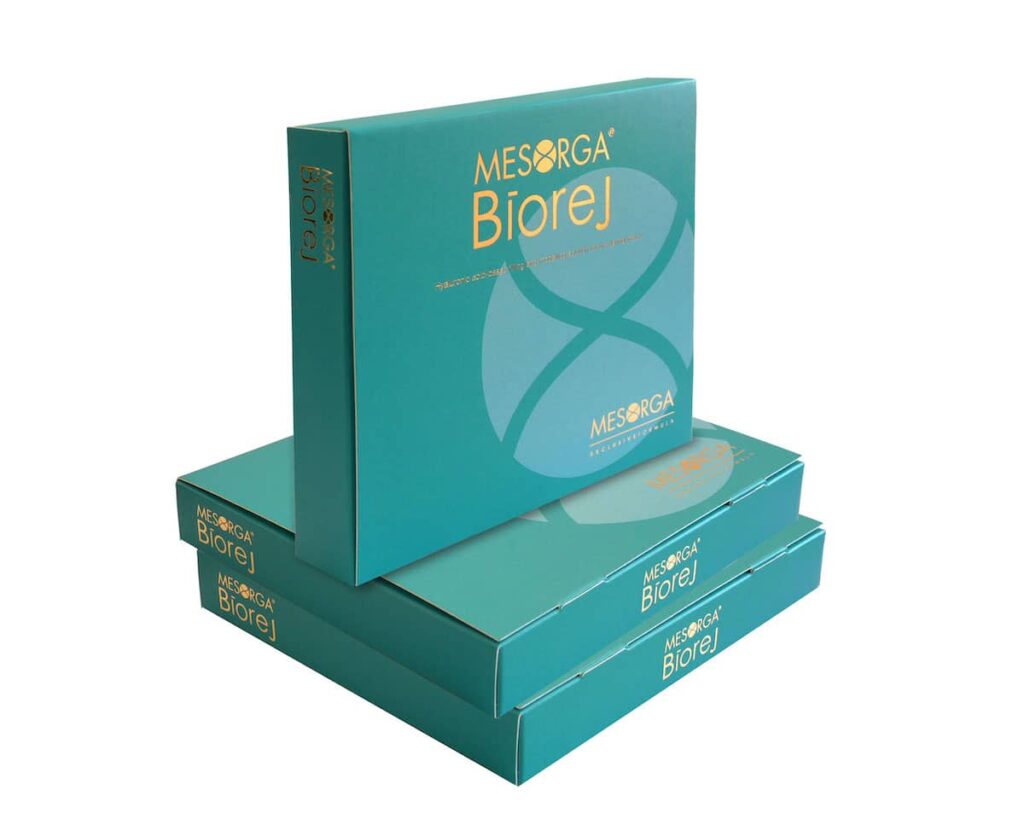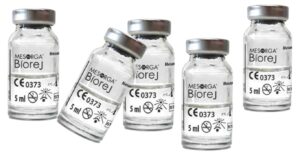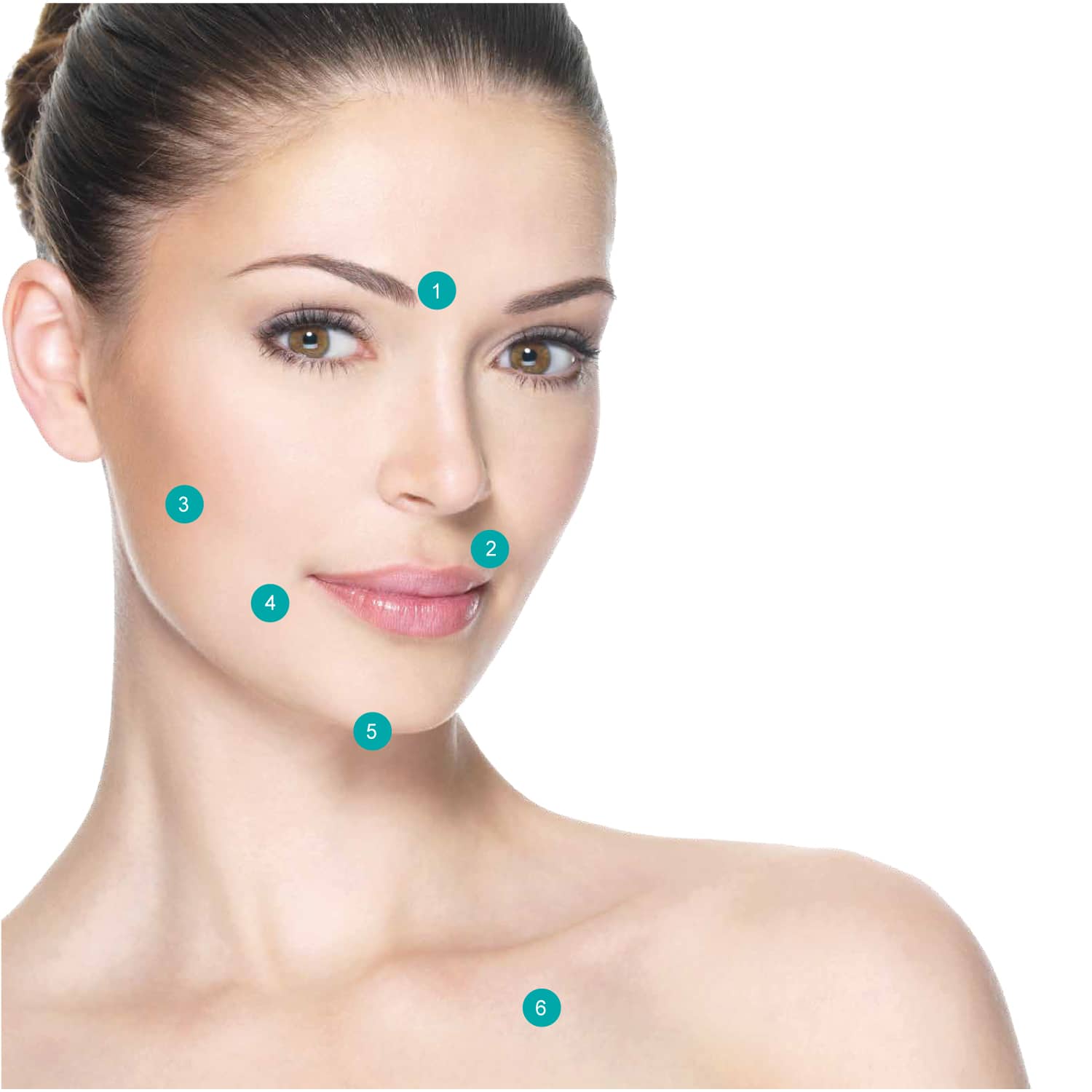Hyaluronic acid-based filling and modelling solution
for the dermal matrix

HYALURONIC ACID: PHARMACOLOGICAL AND CLINICAL EVIDENCE
Hyaluronic acid (HA) is a polysaccharide with extraordinary properties. It’s a large linear polymer, negatively charged, composed of the repetition of disaccharidic units of D-glucu-ronic acid and N-acetyl-D-glucosamine, joined together by glycosydic bonds.
It is the main component of the extracellular matrix (ECM), belongs to the family of glycosaminoglycans (GAG) and is a very large molecule. Within our organism we find it distributed in the form of salt and in high concentrations mainly in connective tissue, in the skin, umbilical cord, synovial fluid, vitreous humor, but also in the lungs, kidneys, brain and muscles.
In recent years, multiple investigations have been carried out which have led to the awareness that HA is synthesized on the inner surface of the cell plasma membrane. The formed chains are then extruded into extracellular space.
It is a highly controlled process carried out by a class of membrane proteins called hyaluronic acid synthetase, consisting of three enzyme subtypes called HAS1, HAS2, HAS3, which act using the nucleotide uridine diphosphate (UDP) capable of alternatingly binding molecules of glucuronic acid and N-acetylglucosamine to the increasing terminal chain, until it reaches a molecular weight of about 4 million daltons.
ROLE OF MOLECULAR WEIGHT AND FUNCTION OF RECEPTORS
It has been shown that the length of HA chains plays an important biological role, because the molecular weight of hyaluronic acid has different effects on cell behavior.
For example:
• short chains seem to stimulate proliferation and induce the onset of transductive waterfalls, which may be involved in angiogenesis and inflammatory responses;
• the longer and heavier chains of HA inhibit cell proliferation in vitro.
The formation of smaller fragments of hyaluronic acid can however take place also thanks to a mechanism called degradation. In fact, in the body there are physiologically present enzymes capable of breaking large molecules of hyaluronic acid by hydrolyzing the β1-4 bonds between the residues of N-acetyl-D-glucosamine and D-glucuronic acid. These enzymes are called hyaluronidase, β-D-glucuronidase and β-N-acetyl-hexosaminidase.
Degradation leads to the formation of very low molecular weight hyaluronic acid, which exhibits different properties and a lower viscosity which increases its tissue permeability.
Once formed, the HA produced has a physiological turnover of 10-100 mg / day in adult men and is mainly metabolized by liver endothelial cells and eliminated by the kidneys.
Hyaluronic acid performs its function by covalently binding to a variety of proteins, called ialaderins, influencing their function: these proteins are called binding proteins and include, among others, CD44, RHAMM, TNFIP6, Brevicano, SHAP, LYVE1 receptors. Some of these are found in the extracellular matrix (ECM), some bound to cell membranes.
IMPORTANCE OF CD44 RECEPTORS
Various scientific studies indicate that, among the various receptors, CD44 is the membrane protein that binds the most represented HA: it is a glycoprotein widely expressed in different cell types, and in particular it is abundant in macrophages. Many of the properties recognized to hyaluronic acid seem to be due precisely to the ability to interact with CD44, in fact the interaction with this receptor plays an important role in the development and resolution of inflammation, in the activation and recruitment of T cells, in growth and tumor metastases.
HA is also able to influence behaviors such as cell proliferation, differentiation and migration.
Based, therefore, on the synthesis of all the studies and experiences related to the use of hyaluronic acid and amino acids, Mesorga created Biorej®, a sterile injectable class 3 medical device, based precisely on biostimulation caused by the activation of CD44 receptors; in fact, among the various receptors present on the surface of fibroblasts, the formation of reticular collagen, that is the characteristic collagen of young skin, is induced by CD44, capable of carrying out therefore, if correctly stimulated, a real dermal regeneration.
It is now scientifically proven that the activation of CD44 receptors is possible only in 2 ways:
A) through the use of platelet growth factors;
B)through the use of products based on “fragments” of hyaluronic acid in a range between 20 and 38 monomers.

COMPOSITION: Hyaluronic acid, isoleucine, Leucine, Lysine, Proline, Valine, Glycine, Serine, Alanine, Cysteine, Phosphate buffer system
Contains:
5 5-mL vials for intradermal use.
“ TAKE YOUR SKIN TO THE NEXT LEVEL “
HYALURONIC ACID-BASED DERMAL MATRIX FILLING AND SHAPING SOLUTION

MESORGA® BIOREJ
MESORGA® BIOREJ is, in fact, made up entirely of fragments of hyaluronic acid in the range between 20 and 38 monomers and precursor amino acids of collagen, elastin and glycosaminoglycans: among these, Leucine and Isoleucine are two essential amino acids that our body cannot produce on its own, known to support the production of growth hormones, responsible for tissue reproduction and to counteract hair loss; moreover, the combination with the other amino acids Glycine and Proline helps to improve the appearance of the skin due to the function of restoring and increasing hydration, firmness and elasticity.
Lysine plays an essential role in the production of collagen providing stability and resistance to traction of the skin, helping to maintain the tone of the skin surface by strengthening its supporting elements as well as having a repairing function for damaged skin and hair.
Valine, on the other hand, is necessary for the normal functioning of the skin and is very important for the strength of the tissues of our skin.
Cysteine is used to produce the vital antioxidant Glutanion (tripeptide of glutamate, cysteine and glycine) for the detoxification of the skin from all types of pollution and oxidative stress.
Alanine and Serin are part of the non-essential amino acids, or rather those that our body is able to produce, but which are still important:
• Alanine for the elaboration of vitamin B as an anti-inflammatory and also to support the detoxification of the organism;
• Serine which contributes to the production of globulins and antibodies and has very important natural moisturizing properties.
Mesorga® Biorej is also equipped with a bicarbonate-based buffer system, through which, by buffering the acidity of the matrix, it maintains the sol state of the colloidal solution, facilitating metabolic exchange.

AREAS AND PROTOCOLS OF USE
Mesorga® Biorej is suitable for all skin types and can be used in all areas of the face and body that need to be revitalized and has biostimulating properties by injecting small doses into the superficial layer of the dermis.
We recommend, with protocols customizable by the doctor according to age or skin type, cycles of at least three treatments for the first month and at least two for the second month, followed by a maintenance of 30 days.
- Glabellar area
- Nasolabial folds
- Zygomatic area
- Perioral wrinkles
- Submental area
- Neck, Décolleté, Hands
* and all parts of the body that need biorevitalization



